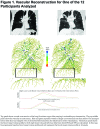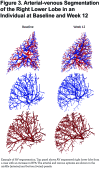Morphologic Response of the Pulmonary Vasculature to Endoscopic Lung Volume Reduction
- PMID: 26587564
- PMCID: PMC4648543
- DOI: 10.15326/jcopdf.2.3.2014.0164
Morphologic Response of the Pulmonary Vasculature to Endoscopic Lung Volume Reduction
Abstract
Introduction: Endoscopic Lung Volume Reduction has been used to reduce lung hyperinflation in selected patients with severe emphysema. Little is known about the effect of this procedure on the intraparenchymal pulmonary vasculature. In this study we used CT based vascular reconstruction to quantify the effect of the procedure on the pulmonary vasculature.
Methods: Intraparenchymal vasculature was reconstructed and quantified in 12 patients with CT scans at baseline and 12 weeks following bilateral introduction of sealants in the upper lobes. The volume of each lung and each lobe was measured, and the vascular volume profile was calculated for both lower lobes. The detected vasculature was further labeled manually as arterial or venous in the right lower lobe.
Results: There was an increase in the volume of the lower lobes (3.14L to 3.25L, p=0.0005). There was an increase in BV5, defined as the volume of blood vessels with cross sectional area of less than 5mm2, (53.2ml to 57.9ml, p=0.03). This was found to be correlated with the increase in lower lobe volumes (R=0.65, p=0.02). The changes appear to be symmetric for veins and arteries with a correlation coefficient of 0.87 and a slope of near identity.
Conclusion: In the subjects studied, there was an increase, from baseline, in BV5 in the lower lobes that correlated with the change in the volume of the lower lobes. The change appeared to be symmetric for both arteries and veins. The study illustrates the use of intraparenchymal pulmonary vascular reconstruction to study morphologic changes in response to interventions.
References
-
- Kramer MR,Refaely Y,Maimon N,Rosengarten D,Fruchter O. Bilateral endoscopic sealant lung volume reduction therapy for advanced emphysema. Chest. 2012;142(5):1111-1117. doi: http://dx.doi.org/10.1378/chest.12-0421 - PubMed
-
- Sciurba FC,Ernst A,Herth FJF,et al. A randomized study of endobronchial valves for advanced emphysema. NEJM. 2010;363:1233-1244. doi: http://dx.doi.org/10.1056/NEJMoa0900928 - PubMed
-
- Martinez FJ,de Oca MM,Whyte RI,Stetz J,Gay SE,Celli BR. Lung-volume reduction improves dyspnea, dynamic hyperinflation, and respiratory muscle function. Am J Respir Care Crit. 1997;155(6):1984-1990. doi: http://dx.doi.org/10.1164/ajrccm.155.6.9196106 - PubMed
-
- Criner GJ,Belt P,Sternberg AL. (et al; and the National Emphysema Treatment Trial Research Group). Effects of lung volume reduction surgery on gas exchange and breathing pattern during maximum exercise. Chest. 2009;135(5):1268-1279. doi: http://dx.doi.org/10.1378/chest.08-1625 - PMC - PubMed
-
- National Emphysema Treatment Trial Group; A randomized trial comparing lung-volume reduction surgery with medical therapy for severe emphysema. NEJM. 2003;348:2059-2073. doi: http://dx.doi.org/10.1056/NEJMoa030287 - PubMed
Grants and funding
LinkOut - more resources
Full Text Sources
Other Literature Sources




